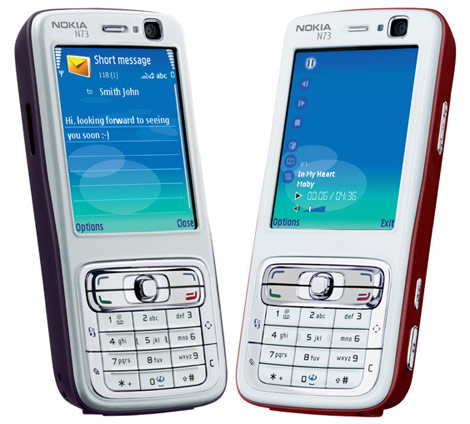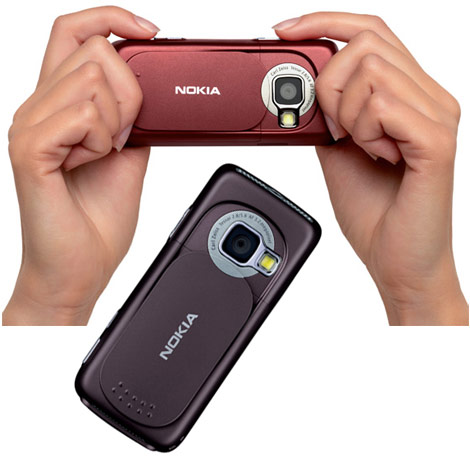The segment of “multimedia computers”, as Nokia calls its Nseries-branded handsets, has always brought in income owing to less feature-packed models, namely phones bearing N7x index. The explanation lies in price and certain conservatism of smartphones-lovers, who usually prefer balanced and well-tuned solutions to gadgets sporting “flagship”, “market’s best proposal” or other titles. The share of so called techi doesn’t change much from market to market or with time – only these enthusiastic users can willingly pay really much for better implementation of certain features, whereas the mass market behaves in a different way. As a result flagships are mostly high profile devices, for example Nokia N93 focuses on video, and the N91 is an outstanding music phone (however in reality the company tries to sell the hard drive in the N91 rather than its music capabilities). Coming down a step, we see how N8x-solutions are aiming at meeting requirements not only of techi, but also those keen on all-in-one devices, which can show off almost each and every available feature, even though most of them won’t be of much use. If you come and think of the Nseries line-up as of a pyramid, the base will consist of N7x handsets, the middle – of N8x and N9x will crown the product line. The company even made a special statement, in which it emphasized that the N70 had managed to claim the title of the market’s most successful UMTS-device and become the company’s income generator. Answering the “Why?” question is really simple – Nokia has forged the today’s market of smartphones and shaped it in the way wee see it, so by redistribution of efforts in this field, it’s able to profit from any solution in its portfolio. For the time being handsets outside the Nseries line-up are non-existent in terms of commercial success (the exceptions are Nokia 3250, Nokia 5500, both devices generate good sale rates in their niches). And so happens that the most widely-spread handset is Nokia N72, while Nokia N73 is destined to make big noise and forge into the lead in Nseries (spec sheet, price/quality ratio and the company’s margins). As a matter of fact this device is more likely to get in one row with long-lasting handsets – the features found in the N73 will actually materialize in the devices which will be released in the yet distant year of 2007.

What’s I’m going to do now I call “Lyrical digression or observation on handsets positioning”. When Nokia announced the Nseries in the first place, it limited itself to a finite volume of this product line by assigning two-digit indexes and, on top of that, starting with the higher ones. Today we might witness announcement of N6x devices, which in fact will be the most simplified smartphones targeted at the mess market and promoted with all due pomp. At the same time advent of N5x series is not as impossible as it would seem, since it puts special emphasis on the very concept of feature-packed smartphones (all-in-one devices). Should Nokia go on at its current pace of announcements, the existing index potential will run out in 3 years, and that will mean either the need of changing the course or reconsidering the current state of affairs with positioning. The latter option is less probable, since it will provoke heated debates (for example extending the base index to three digits), thus at present changing the concept and introduction of a new device series might be Nokia’s next step.
Over at Nokia they tried to boost the N73 using various technologies so that it could not only impress end-users on imaging front but also offer fair basic functionality. The aim at the mass market has eventually resulted in three different trims - Silver Grey/Deep Plum, Frost White/Metallic Red, Frost White/Mocha Brown, however all they have only the rear and sides painted, while the light front plate remains almost untouched There is not much of a difference between two color schemes (Deep Plum, Mocha Brown) – it’s more about color tones. On the other hand the Metallic Red stands out against the background of its companions and will sure appeal to women. Hereafter the market will see launch of a black edition – whether it will be only an addition to already released trims, or a limited offering materialized owing to another promo-action, we do not know.


The smartphones by Nokia are getting smaller with every release, and this case isn’t an exception – in fact, it’s the apex of miniaturization of smartphones incorporating QVGA screen. Today only Nokia 5500 can overcome the N73 dimensions-wise, but it still yields to the latest N7x’s offspring when it comes to display. The Nokia N73 measures 110х49х19 mm in size and weights 116 grams. In future the dimensions in this series will vary within the limits of these sizes, further reduction won’t take place.

If we are to draw a parallel between ordinary handsets retaining comparable functionality, Sony Ericsson K800i, for example, measures up at 106х47х21 mm in its thickest camera part (the rest of casing is 18 mm thin), weight 113 grams. Although there is a difference in the dimensions between these two devices, don’t think of it as a huge gap – all in all, the handsets feel pretty much the same size-wise.
Video, comparison of dimensions with other handsets (wmv, 10.5 Mb)>>>



The model’s display boasts a diagonal of 2.4 inches (37x50 mm) and capable of showing up to 262 colors (TFT) at a resolution of 240x320 pixels. Exactly the same screen is adopted by Nokia N71 and there is no wonder in that: it looks and feels great, has the right proportions. It’s interesting to know that VGA screens will use comparable diagonals – the platform is being turned nowadays, so that by the time these displays hit the market it will have been ready to operate with them. The picture on the N73 looks fine and allows for no criticism. Besides, the display is armed with a translucent metallic substrate, ensuring that information on the screen will remain readable even in the sun – it’s a signature of the models retaining to the latest generation.




The building quality appears very good just until the moment to put your fingers on the back cover with an integrated lens shutter. At the left of the latch there is a cavity, which makes the entire casing groan and crack even at slightest touches. That’s the worst thing about the N73’s assembling quality and it’s almost impossible to deal with without special tools - foam-rubber or other soft material laid under the cover doesn’t save the day.

The area atop the display features a forward-facing VGA-camera for video calls in 3G networks; however it may deliver photos of self as well. Right next to the that camera you will find a light sensor, automatically adjusting keypad backlighting brightness and turns it off in case the illumination level is sufficient, this sensor also houses a Bluetooth indicator lamp.
No comments:
Post a Comment